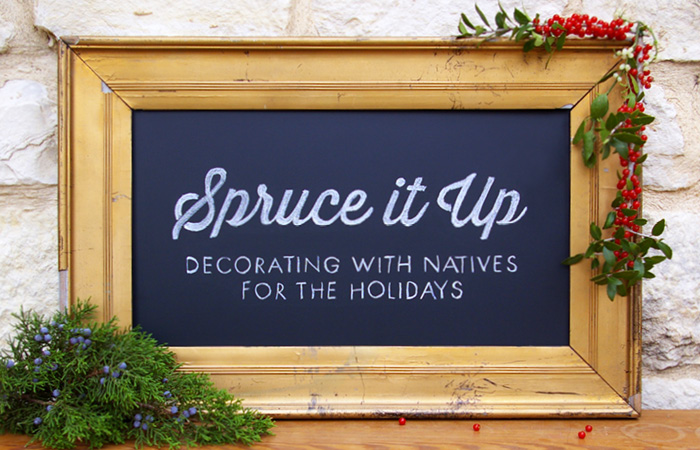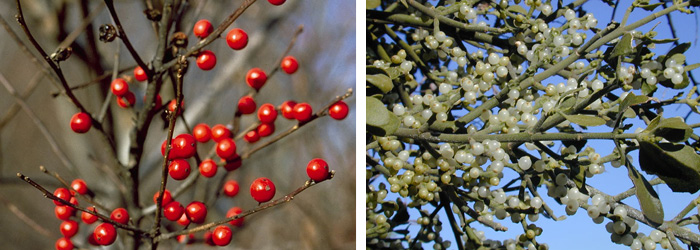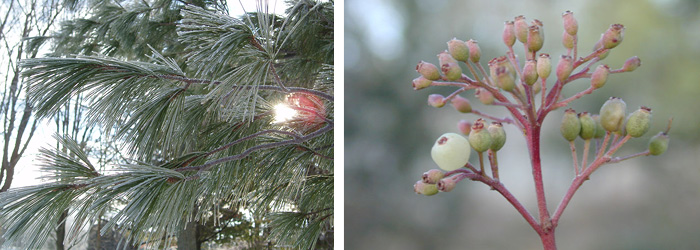
WHEN YOU’RE HAULING OUT THE HOLLY this holiday season, consider all of the native plants that we use to signify the holidays and spruce up our winter decor. The same boughs and berries that shelter and nourish wildlife in winter can enliven an entryway, complete a centerpiece or tie together a mantle. Borrowing from native shrubs and trees planted in your yard for these winter arrangements presents a great opportunity to help bring a natural sense of place from where you live to your home decor.
Winter decorating typically means mistletoe, berries, pinecones, conifer branches and holly boughs — and with so many North American plants in these categories, natives don’t disappoint. Take some inspiration below.
Oh, Ho, the Mistletoe
Much of the mistletoe marketed at holiday time comes from Texas, home to several of the Phoradendron species – the leafy native American mistletoe that resembles Britain’s traditional Christmas mistletoe, Viscum album. Although Brits can take credit for the custom of kissing beneath a mistletoe sprig at holiday time, we Americans don’t lack choices of mistletoe plants.
And although they are infamous for their parasitic nature, mistletoes are not without merit. Oak mistletoe (Phoradendron leucarpum) is the larval host for the great purple hairstreak butterfly. It’s more widespread than fellow mistletoe Phoradendron tomentosum – or Christmas mistletoe – that claims native roots only in Louisiana, Oklahoma and Texas. Both boast shiny, somewhat translucent white berries that could easily be incorporated into a holiday bouquet or centerpiece. Come spring, mistletoes will flower – nourishing pollinators. (And don’t forget to place this somewhere to grab a kiss.)

LEFT Common winterberry (Ilex verticillata) boasts bright-red fruits that stay on branches all winter long. Feature the fruit-covered stems in a simple glass vase for a stunning winter arrangement. PHOTO George H. Bruso RIGHT Christmas mistletoe (Phoradendron tomentosum) is native to Louisiana, Oklahoma and Texas. In winter, female plants reveal shiny, white berries. PHOTO Joseph A. Marcus
Very Berry
It’s hard to imagine the holidays without the small red fruits that grow on holly (Ilex spp.) plants. The most common reference to the plants, though, is to European holly (Ilex aquifolium) – which also boasts the season’s iconic waxy leaf. The North American Ilex plants put on a similar, if less well known, show and are irresistible in native holiday bouquets and centerpieces.
One with a wide native range from Virginia to Texas is possumhaw (Ilex decidua) – a small deciduous tree made conspicuous in winter by its many small, red drupes along leafless, slender, gray twigs. In the north, common winterberry (Ilex verticillata) is also deciduous. Its bright red fruits more than make up for what it lacks in leaves and brighten cold climate landscapes during late fall and early winter.
You can go lightly on the holly should you wish since there are so many other fruit-producing plants to choose from when decorating at holiday time. Red chokeberry (Photinia pyrifolia) gets its pear-shaped, bright-red pomes in fall – and they stay on through January. This one’s native all the way from Nova Scotia into far East Texas. Chokeberry fruits don’t seem to appeal to birds quite like hollies do so you can guiltlessly pluck them for your designs. Birds will flock to the sumacs – staghorn (Rhus typhina) and smooth (Rhus glabra) sumacs enjoy a wide native range. The latter is a larval host for the hairstreak butterfly. Evergreen sumac (Rhus virens) is another native with holiday fruit potential. Although it’s not truly evergreen, this one also has lovely leaves that hang around through winter and could be used in a seasonal arrangement. Sumac is native to every state in the continental United States, so you’re sure to find one that suits your area and your taste.
For out-of-the-box seasonal decor, you might try American beautyberry (Callicarpa americana) berries that persist after the Southern native’s leaves have fallen. (If you can beat the birds, that is…they love these berries.) If the berries are white, they’ll look at home in a traditional red and white holiday color scheme. Don’t despair if your plants bear the more common clusters of magenta berries. These will make for a more original look.

LEFT White pine (Pinus strobus)makes a fine Christmas tree where it is native in the East. PHOTO Julie Makin RIGHT The attractive red stems of roughleaf dogwood (Cornus drummondii) could be used in a one-of-a-kind native holiday arrangement. PHOTO Joseph A. Marcus
Classic Red and Green
Stunners though they are, berries won’t always stand on their own in an arrangement or centerpiece. Holiday decorating is lost without greenery and even bare stems or twigs. Some dogwoods are particularly suited for holiday decorations because of their deep- or bright-red stems. Roughleaf dogwood (Cornus drummondii) could work, and redtwig dogwood (Cornus sericea) is a shoe-in.
As you might expect, pines and cedars will do well in indoor arrangements because they dry out slowly and hold their greenery. As with any plant part you borrow from your yard for your creations, handle with care and be sure to consider what you cut and what you leave. Many cedar (Juniperus spp.) trees have a grey – even blue – cast to their foliage that can help differentiate holiday decor. Eastern red cedar (Juniperus virginiana) is abundant in the East, and Ashe juniper (J. ashei) is native to Texas, Arkansas, Oklahoma and Missouri. Pretty much whichever native conifer you have onsite will offer great foliage – and a fragrant holiday scent. Many a mantle have been draped with garland made from white pine (Pinus strobus) – the Eastern native that makes a popular Christmas tree.
The cones that pines and other conifers produce have inspired hundreds if not thousands of holiday decorations. Use them to form the basis of a wreath or tie them with ribbon and hang them from doorknobs or in the windows. Finally, whether you make the South your home or not, who can resist a wreath made from Southern magnolia (Magnolia grandiflora) leaves? Among the most beautiful of native trees, it’s no wonder the dried leaves look tailor-made for the holidays on the mantle, at the table mixed with red berries or hanging on your front door.

